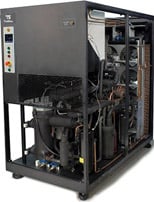

How Fluid Chillers Work
Designing a high reliability chiller requires an in depth understanding of chiller components, including their limitations as applied to specific cooling applications. A reliable and functional chiller system is a result of quality engineering and manufacturing activity. When properly executed, ROI goes well beyond the initial commissioning at the point of application.
Download the entire brochure "Principles of Fluid Chillers: Design Criteria for Reliable Operation"
How a Chiller Works:
A process chiller removes heat from a heat source – an environment where temperature must be maintained on a continuous basis, otherwise known as the process. Heat removal is based on the principle that heat will move from a hotter source to a colder source.
A chiller comprises two main parts called circuits – a fluid and refrigeration circuit. These circuits, especially refrigeration, become more complex as temperature requirements drop below -40°C. With low- and ultra-low temperature cooling, system design incorporates additional cooling circuits (called two-stage, three-stage, and autocascade systems) and refrigerants.
A chiller transfers the heat from the process to the fluid circuit then to the refrigeration circuit and finally to the condenser where it is expelled.
- An air-cooled condenser expels heat by blowing cool air across the condenser, moving heat into the atmosphere.
- A water-cooled condenser expels heat by circulating cool water through lines in the condenser. The water moves the heat to an external cooling apparatus.
What constitutes high reliability chiller operation? It begins with design – matching component capacity to cooling requirements. Specifying the right components (valves, fluids, pumps, etc.) is critical. The interactive diagram below shows a chiller with single-stage refrigeration. It describes the major components of a chiller and their importance to reliable operation in the selection of a specific design.
Refrigeration Circuit
Compressor
The compressor is the heart of the refrigeration circuit; it circulates the refrigerants. Hermetically sealed (air-tight) compressors are leak proof and typically more reliable. The type of hermetic compressor used depends on the application. This includes required horsepower (Hp), noise level and footprint. Typically, reciprocating compressors are smaller, used in applications that require less than 2 Hp. Scroll compressors are used in applications requiring more than 2 Hp, low noise levels, or extended operation periods.
Condenser
The condenser removes heat from the refrigeration circuit and expels it using air or water as the transfer medium. During heat removal the refrigerant condenses, changing the refrigerant from gas to liquid. The condenser should be sized to the application; air condensers are larger than water condensers because air is a less efficient heat transfer medium than water.
Refrigerant Lines
Refrigerant lines are copper tubes that carry the refrigerant through the refrigeration circuit. The manufacturing process of these lines is critical to the chiller’s overall reliability. Fully brazed (metal-joining process) refrigerant lines with hermetically sealed solenoid valves prevent leaks and contamination from external sources. Proprietary refrigerant additives keep the lines free of oil and contaminants. Additionally, each refrigeration circuit is treated with a proprietary cleaning process, which prevents erosion or thinning of the tubes. Finally, every refrigeration circuit is leak tested.
Thermal Expansion Valve
The Thermal Expansion Valve (TXV) acts as a metering device that regulates the amount of refrigerant allowed into the Heat Exchanger (HTX). The TXV bulb is filled with a gas that expands and contracts based on the temperature it monitors at the outlet of the HTX. The expansion and contraction opens and closes the TXV as needed.
Heat Exchanger (Evaporator)
The Heat Exchanger (Evaporator) is where the refrigeration circuit removes heat from the fluid circuit. The Thermal Expansion Valve on the inlet of the Heat Exchanger creates a pressure drop as the refrigerant enters the Heat Exchanger. This pressure drop forces the refrigerant to evaporate (i.e. changes from liquid to gas). As the refrigerant evaporates, it expands and becomes very cold. The cold gas lines run next to the fluid lines in a counter-flow direction. This configuration ensures maximum heat transfer from the fluid as it exits the Heat Exchanger. Fully brazed heat exchangers are the most reliable and efficient design; providing the best heat transfer and leak proof protection.
Fluid Circuit
The fluid circuit removes heat from the process and transfers it to the refrigeration circuit. A variety of fluids and pump types may be used depending on the application. The fluid picks up heat from the process and is pumped into the heat exchanger where it is cooled as it circulates back to the process.
Fluid Reservoir
The Fluid Reservoir holds fluid that is not circulating through the fluid circuit. The purpose of a reservoir is twofold: to fill the lines initially and to serve as an expansion tank as the fluid expands and contracts. The reservoir may be manually filled using Fluid Fill and Vent ports or it may be connected to an external fluid supply that automatically refills the reservoir when levels are low. Typically, reservoirs are stainless steel to prevent contamination of fluid.
Pump
The pump is the heart of the fluid circuit; it circulates fluid through the fluid lines. Positive Displacement Gear Pumps and Velocity Turbine pumps are typically the most reliable and best performing pumps. Choosing between them depends on the application. Typically Gear Pumps are used when fluids are extremely viscous and exhibit a high level of lubricity. Gear Pumps need to be lubricated; they create high pressure capable of moving viscous liquids. Turbine pumps are used when high flow rates or low noise levels are required. Turbine pumps have fewer moving mechanical parts than gear pumps; they are quieter and require less lubrication.
Heat-transfer Fluids
Fluid types vary with the temperature requirements, from water at ambient and above, to water/glycol mixture below freezing, and proprietary blends below -40 to -110C.
Process Material
Heat removal can be accomplished with a variety of fluids and materials. However, their selection must be chemically compatible with the process material they will contact. For example, copper lines passing through the pump, heat exchanger and reservoir would be corrosive to cooling an aluminum-based process. Considerations for selection of wetted materials used in components making up the fluid circuit:
| PROCESS LOOP MATERIAL | WETTED MATERIALS (FLUID CIRCUIT) |
|---|---|
| Copper | Cu, Brass, SS, Engineering Plastic |
| Aluminum 1 | SS, Brass, Engineering Plastic 2,3 |
1. Deionized water (purified water with mineral ions removed – sodium, calcium, iron, copper, chloride, bromide) is a commonly used fluid to prevent corrosion of aluminum for temperatures above freezing.
2. Stainless steel, brass and plastic tubing and joints are free of oxidative ions.
3. For ultra-pure applications, stainless steel welds and finishes require a passivation process to restore its chromium oxide surface.
Fluid Supply and Fluid Return
Cold fluid exits the chiller at the Fluid Supply port, removing heat generated by the process. Warm fluid returns to the chiller through the Fluid Return port to begin the heat extraction and cooling process again.
Controller
The controller is the traffic cop that directs chiller operations by controlling temperature, communicating chiller health and keeping records. For example, it typically monitors temperatures, process flow and reservoir level, provide notification if any variable trends to out of range, and transmits chiller information, and logs diagnostics. The controller should be compatible with your communications protocols for remote monitoring and control.


